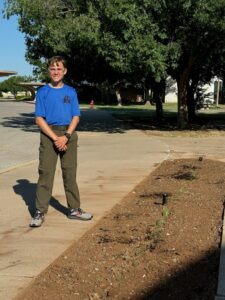Eagle Project

Eagle Project
Service to other people is what Scouting is all about. In many ways, a service project reflects who you are as a youth leader. Your result should have a significant impact on your community to be special and should represent your very best effort.
Your proposal, the logical first step, should emphasize your intention to give leadership to others through proper planning and development. Always communicate with the beneficiary often to ensure the project meets the organization’s needs once it is completed.
We are encouraged to seek guidance from your unit leader and project coach as we need help. The Eagle Scout Service Project Workbook, much like a compass, will help us navigate our way to a life of service as a proud Eagle Scout.
I hope you enjoy this project as much as I have planned and learn about the Native plants of Oklahoma.
Weston Savage Hurst Life Scout /(Eagle)
Project Design
There are thousands of possible Eagle Scout projects. Some involve building things, and others do not. There have been all kinds: making birdhouses for an arboretum, conducting bicycle safety rodeos, constructing park picnic tables or benches, upgrading hiking trails, planting trees, conducting well-planned blood drives, and on and on. Other than the general limitations noted below, there are no specific requirements for project scope or for how many hours are worked, and there is no requirement that a project have lasting value. What is most important is the impact or benefit the project will provide to your organization.
Content Creation
My intent for this project is to educate everyone who comes to the Museum of the Great Plains. Education has always been my cornerstone, I learned from my parents that education is so important that it must come before other things in life. I have been in the scouts since I was six years old, and I have always had a love for the outdoors. So, this project was near to my heart, because I could bring some of the beauty of the outdoors to someone that might not ever get to see it in color.

Native plants in Oklahoma can be beneficial for many reasons, including:
- Supporting wildlife
Native plants provide food and habitat for local wildlife, such as birds, pollinators, and small mammals. Pollinators, like bees, butterflies, and hummingbirds, have evolved with native plants and are best adapted to the local climate, soil, and growing season.
- Preventing invasive species
Using native plants can help prevent the spread of invasive species and the problems they can cause.
- Conserving water
Native plants are more drought-tolerant and require less water than plants from other regions.
- Protecting soil
Native plants can help protect soil from erosion.
- Regulating ecosystems
Native plant diversity provides ecosystem services that regulate carbon and water cycles.
- Enhancing gardens
Native plants can add beauty to gardens with their variety of colors, shapes, and textures. They also require less maintenance because they’ve adapted to the local climate and soil conditions over thousands of years.

